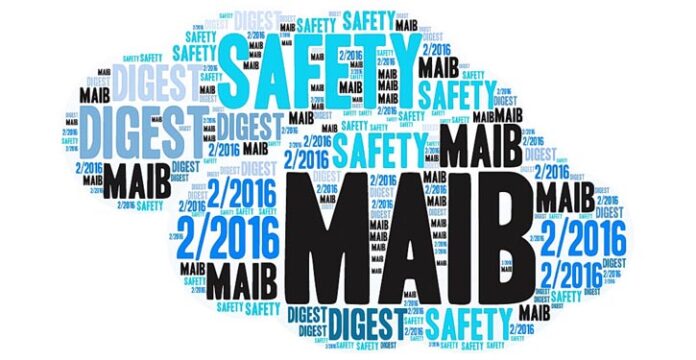The latest edition of the Safety Digest 2016 contains insightful information in 25 articles which are examples of poor risk awareness demonstrated by the crews of vessels from the merchant, fishing and recreational sectors.
The document highlights the disconnect that sometimes occurs between a company’s official safety culture and the actual operation of the vessel. The Marine Accident Investigation Branch (MAIB) examines and investigates all types of marine accidents to or on board UK vessels worldwide, and other vessels in UK territorial waters. The MAIB has published the latest edition of its safety digest 2016. The Safety Digest draws the attention of the marine community to some of the lessons arising from investigations into recent accidents and incidents. It contains information which has been determined up to the time of issue.
The MAIB has once again pulled together an excellent summary of incidents, some of which it has investigated. It is in a format that is both easy to read and to identify the lessons learned. This is a most commendable effort by the MAIB, and I hope the readers of this latest digest of reports will put the lessons learnt into good practice. As usual it can be seen, that there are a wide range of contributory factors that result in maritime accidents and incidents. However the one contributory factor occurring consistently throughout the reports is the Human Element – people’s ability and capability to deal effectively and safely with the complexity, difficulty, pressures and workload of their daily tasks, not only in emergency situations, but also during routine operations.
Crewmembers and the ship’s superintendents should ask themselves, “What is normal on board our ships?” In one case it was to sail on a routine basis with inadequate stability! In others there appeared to be no risk assessments undertaken and an absence of a management of change process.
Seafarers now undertake mandatory training in resource management, leadership and team working skills at an operational level, then leadership and managerial skills at management levels. So why do we still read about Masters demonstrating rule breaking behaviours and equally, not being challenged by the Officers? The Master of a passenger ship that went aground had not amended the passage plan when a new destination for anchoring was required – subsequently, without a plan to work with, the Bridge Team was unable to adequately assist the Master. After the grounding the Master did not use the emergency checklist available to him and took the ship full of passengers to sea. A great deal of time and experience goes into preparing emergency checklists. Their use provides a ready-made strategy to ensure that mistakes and omissions in the heat of the moment do not make a bad situation worse.
Navigation and collision avoidance aside, the OOW (Officer of the Watch) also needs to be available to respond to emergencies such as fire, machinery breakdown and man overboard. In one case reported in this edition, the OOW was not on the bridge for 20 minutes – the OOW is required to maintain a continuous watch on the Bridge for good reasons! The Maritime and Coastguard Agency (MCA) has recently issued Marine Guidance Note MGN 520(M). It contains the “Deadly Dozen” which describes the most common people based factors in maritime safety, with suggested mitigating actions. Readers are recommended to read the MGN 520(M) in conjunction with the findings included in this digest.
CHIRP (Confidential Hazardous Incident Reporting Programme) aims to seek out root causes for near misses, identify the lessons learned and to consider how best this information can be used to prevent reoccurrence elsewhere in the maritime industry, whilst not apportioning blame to any company or individual whatsoever. Near miss reports that have been received by CHIRP over the last 12 years were analysed using the “Deadly Dozen” human factors definitions and the top five failings were identified. These accounted for 75% of the causal factors in maritime incidents, namely failures in: situation awareness, alerting others, communication, complacency, and the safety culture onboard. All of these items can be seen to have surfaced in the full incident reports investigated by the MAIB. People need to learn more from near misses and hazardous occurrence reporting.
“Reading these reports from the comfort of an armchair or as a dedicated professional at your place of work, some of the casual factors in this digest of reports appear to be unbelievable in this modern age of advanced technology and training, but they did happen and unless the lessons learned are consistently applied, as advised in this and previous MAIB publications, we shall be reading similar reports in the future. Ask yourself what safety margins you are working to and are these sufficient when taking into account the exposure to potential risks? Please remember the lessons learned here will not only apply to seafarers but also to people at all levels and positions within the overall wider maritime system. Let us all try harder to send all seafarers safely home to their family and loved ones at the end of each and every trip”, says Captain John Rose, CHIRP Director.
Beitrag: UK Marine Accident Investigation Branch (MAIB)/PP




